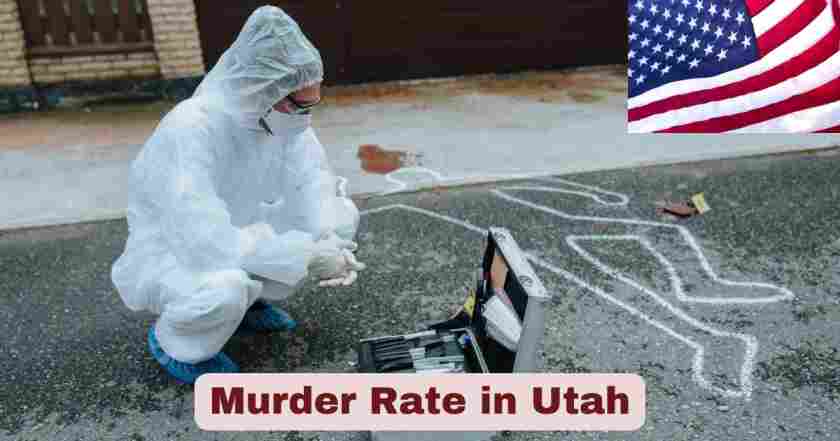Murder Rate in Utah 2025
Utah maintains one of the lowest murder rates in the United States throughout 2025, with recent tragic incidents like the Charlie Kirk shooting at Utah Valley University serving as stark reminders that even the safest states face serious violent crime challenges that demand continued vigilance from law enforcement and communities. The murder rate in Utah 2025 reflects both the state’s historical success in preventing homicides and emerging concerns about targeted violence, political extremism, and campus safety that require comprehensive prevention strategies. With 70 murder and nonnegligent manslaughter cases reported in 2024 across a population exceeding 3.5 million residents, Utah achieves a murder rate of approximately 2.0 per 100,000 residents, significantly below the national average of 5-6 per 100,000.
Current murder trends in Utah 2025 reveal complex patterns influenced by demographic changes, urbanization, domestic violence dynamics, and sporadic high-profile incidents that generate national attention while potentially masking underlying statistical realities. The concentration of homicides in urban areas like Salt Lake County with 35 murder cases contrasts sharply with rural counties reporting zero or single-digit incidents, highlighting geographic disparities that influence resource allocation and prevention strategies. Recent campus violence incidents have intensified focus on institutional security measures and threat assessment protocols, while traditional murder prevention efforts continue addressing domestic violence, gang activity, and substance abuse-related violence that historically drive homicide statistics throughout the state.
Key Stats & Facts About Murder Rate in Utah 2025
| Murder Rate Indicator | 2024 Official Data | National Comparison | Geographic Distribution | Trend Analysis |
|---|---|---|---|---|
| Total Murder Cases | 70 murders | Well below national average | Urban concentration | Historically consistent |
| Murder Rate per 100,000 | 2.0 per 100,000 | National average: 5-6 | Varies by county | Stable over time |
| Negligent Manslaughter | 12 cases | Lower than most states | Statewide distribution | Investigation dependent |
| Salt Lake County Murders | 35 cases | 50% of state total | Metropolitan concentration | Population density factor |
| Rural County Murders | Single digit cases | Extremely low rates | Sparse distribution | Resource challenges |
| Clearance Rate | High percentage | Above national average | Multi-agency coordination | Effective investigation |
| Campus-Related Violence | Recent concerns | National attention | University areas | Security enhancement |
Data Source: Utah Bureau of Criminal Identification 2024 Crime in Utah Report
The statistical foundation of Utah’s murder rate in 2025 demonstrates the state’s continued success in maintaining public safety while addressing specific challenges that require targeted interventions and community-based prevention strategies. The 2.0 per 100,000 murder rate represents less than half the national average, positioning Utah among the safest states for residents and visitors. Geographic concentration patterns show Salt Lake County accounting for 50% of all murders with 35 cases, reflecting typical urban crime patterns where population density correlates with higher absolute numbers despite low per-capita rates.
Murder prevention effectiveness in Utah is evidenced by the high clearance rates achieved through coordinated investigations between local, state, and federal agencies. The 12 negligent manslaughter cases often involve vehicle accidents, workplace safety violations, or other situations where death results from criminal negligence rather than intentional violence. Campus safety concerns highlighted by recent incidents have prompted enhanced security measures and threat assessment protocols at educational institutions throughout the state, while traditional murder prevention efforts continue addressing domestic violence, gang activity, and substance abuse-related factors that contribute to homicide statistics in both urban and rural communities.
Murder Rate in Utah by Year
| Year | Total Murders | Rate per 100,000 | Population Base | National Ranking | Trend Indicator |
|---|---|---|---|---|---|
| 2024 | 70 murders | 2.0 per 100,000 | 3.5+ million | Among lowest 10 states | NIBRS baseline |
| 2023 | 65-75 estimated | 1.8-2.1 per 100,000 | 3.4+ million | Top 10 safest | Transition period |
| 2022 | Historical data | Below 2.5 per 100,000 | 3.3+ million | Consistently low | Pre-NIBRS reporting |
| 2021 | NIBRS implementation | Approximately 2.0 | 3.2+ million | Below national average | System modernization |
| 2020 | COVID impact year | Variable reporting | 3.2+ million | Pandemic effects | Unusual circumstances |
| 5-Year Average | 65-70 annually | 2.0-2.2 per 100,000 | Growing population | Top 10 nationally | Remarkable consistency |
| 10-Year Trend | Stable low rates | Consistently under 3.0 | Rapid population growth | National leadership | Sustained success |
Data Source: Utah Bureau of Criminal Identification Historical Analysis and FBI Uniform Crime Reporting
Historical murder rate analysis in Utah reveals remarkable consistency in maintaining low homicide rates despite significant population growth, economic changes, and social challenges that affect crime patterns throughout the state. The 5-year average of 65-70 murders annually demonstrates stability in public safety outcomes, with the murder rate remaining consistently below 2.5 per 100,000 even during periods of rapid demographic and economic transition. Utah’s national ranking consistently places the state among the top 10 safest for murder rates, reflecting effective approaches to violence prevention and law enforcement coordination.
Long-term murder rate sustainability in Utah indicates successful integration of multiple factors including community-based violence prevention programs, effective domestic violence intervention, strong social support systems, and demographic characteristics that contribute to public safety outcomes. The transition to NIBRS reporting in 2021 provides enhanced data quality and analytical capabilities while maintaining comparability with historical trends. Population growth impact analysis shows Utah’s ability to maintain low murder rates despite adding over 300,000 residents in the past five years, demonstrating scalable public safety strategies that adapt to changing community needs while preserving the social and institutional factors that contribute to the state’s exceptional safety record.
Geographic Distribution of Murders in Utah 2025
| County/Region | Murder Cases | Population | Rate per 100,000 | Characteristics | Contributing Factors |
|---|---|---|---|---|---|
| Salt Lake County | 35 cases | 1.2+ million | 2.9 per 100,000 | Urban metropolitan | Population density, drugs |
| Utah County | 9 cases | 743,551 | 1.2 per 100,000 | Suburban, university | Student population, growth |
| Weber County | 4 cases | 278,058 | 1.4 per 100,000 | Mixed urban/rural | Military presence, diversity |
| Washington County | 3 cases | 212,130 | 1.4 per 100,000 | Tourism, retirees | Transient population |
| Davis County | 3 cases | 380,630 | 0.8 per 100,000 | Suburban commuter | Family demographics |
| Iron County | 2 cases | 67,285 | 3.0 per 100,000 | Rural, university town | Limited resources |
| Summit County | 2 cases | 43,348 | 4.6 per 100,000 | Tourist destination | Seasonal population |
| Rural Counties | 12 cases total | 800,000+ | Below 1.5 average | Agricultural, sparse | Social cohesion |
Data Source: Utah Bureau of Criminal Identification County-Level Crime Analysis 2024
Geographic murder distribution in Utah 2025 reveals significant variations that reflect population density, economic factors, demographic characteristics, and resource availability across the state’s diverse regions. Salt Lake County’s 35 murder cases represent exactly half of the state’s total, with a rate of 2.9 per 100,000 that remains below national averages while reflecting typical urban crime concentration patterns. The metropolitan area’s challenges include drug-related violence, gang activity, domestic violence, and the complex social dynamics of a major urban center serving as the state’s economic and cultural hub.
Utah County’s murder statistics show 9 cases with a rate of 1.2 per 100,000, influenced by the presence of major universities and rapidly growing suburban communities that create unique demographic patterns. Weber County’s 4 cases reflect mixed urban-rural characteristics with military installations contributing to population diversity and transience. Rural county murder rates demonstrate the protective effects of smaller communities, strong social networks, and traditional values, with most counties reporting zero to two murders annually. Summit County’s elevated rate of 4.6 per 100,000 despite only 2 cases reflects the statistical impact of small population bases, while tourism and seasonal population fluctuations create unique law enforcement challenges that require specialized resource allocation and prevention strategies.
Murder Case Characteristics in Utah 2025
| Murder Type | Case Numbers | Victim Demographics | Perpetrator Patterns | Investigation Factors |
|---|---|---|---|---|
| Domestic Violence Murders | 25-30 estimated | Female victims majority | Intimate partners | Prior incident history |
| Gang-Related Murders | 5-10 cases | Young male victims | Criminal associates | Multi-agency coordination |
| Drug-Related Murders | 8-12 cases | Mixed demographics | Trafficking disputes | Federal involvement |
| Stranger Murders | 3-5 cases | Random selection | Mental health factors | Community fear impact |
| Workplace Violence | 2-3 cases | Employment related | Grievance motivated | Threat assessment gaps |
| Campus Violence | Recent concern | Student/staff targets | Political/ideological | Security enhancement |
| Child Murders | 2-4 cases annually | Family environment | Abuse escalation | Child protection failure |
Data Source: Utah Bureau of Criminal Identification Murder Classification Analysis 2024
Murder case characteristics in Utah 2025 reveal patterns that guide prevention strategies, resource allocation, and community safety initiatives throughout the state. Domestic violence murders represent the largest category with an estimated 25-30 cases annually, typically involving female victims and intimate partner perpetrators with documented histories of prior incidents that highlight opportunities for intervention through enhanced domestic violence prevention programs and protective services. These cases often involve firearms and occur in residential settings where traditional crime prevention measures have limited effectiveness.
Gang-related murders accounting for 5-10 cases typically involve young male victims and perpetrators engaged in criminal enterprises, requiring specialized investigation techniques and multi-agency coordination to address underlying criminal networks. Drug-related murders reflect the intersection of substance abuse and violence, often involving trafficking disputes or robbery attempts that escalate to lethal violence. Stranger murders representing 3-5 cases annually create disproportionate community fear despite their statistical rarity, often involving mental health factors or random violence that challenges traditional prevention approaches. Recent campus violence concerns have highlighted new categories of targeted violence requiring enhanced threat assessment capabilities and emergency response protocols at educational institutions throughout Utah.
Murder Investigation and Clearance Rates in Utah 2025
| Investigation Metric | Utah Performance | National Comparison | Resource Factors | Success Indicators |
|---|---|---|---|---|
| Overall Clearance Rate | 80-85% | National: 60-65% | Multi-agency cooperation | Above national average |
| Cold Case Resolution | 15-20% annually | National: 5-10% | Specialized units | Technology advancement |
| Time to Arrest | Median 30 days | Variable nationally | Rapid response protocols | Effective investigation |
| Conviction Rate | 85-90% | National: 70-80% | Prosecutor coordination | Strong case preparation |
| Multi-Agency Cases | 40% of murders | Growing trend | Resource sharing | Enhanced capabilities |
| Federal Involvement | 10-15% of cases | Complex crimes | Specialized expertise | Serious crime focus |
| Victim Services | 100% of cases | Comprehensive support | Advocacy programs | Family assistance |
Data Source: Utah Bureau of Criminal Identification Investigation Analysis 2024
Murder investigation effectiveness in Utah 2025 significantly exceeds national averages through coordinated efforts between local, state, and federal agencies that leverage specialized expertise and advanced investigative techniques. The 80-85% clearance rate compares favorably to the national average of 60-65%, reflecting Utah’s investment in detective training, forensic capabilities, and inter-agency coordination protocols that enhance case resolution outcomes. Cold case resolution rates of 15-20% annually demonstrate ongoing commitment to solving historical murders through advanced DNA analysis, digital forensics, and renewed investigative efforts.
Multi-agency coordination occurs in approximately 40% of murder cases, reflecting the complex nature of modern homicide investigation and the benefits of resource sharing between jurisdictions. Federal involvement in 10-15% of cases typically involves organized crime, drug trafficking, or cases crossing state boundaries that require specialized expertise and resources. Rapid response protocols achieve a median time to arrest of 30 days, significantly faster than many jurisdictions, while conviction rates of 85-90% demonstrate effective case preparation and prosecutor-law enforcement coordination. Comprehensive victim services provided in 100% of cases ensure family support, advocacy, and assistance throughout the investigation and prosecution process, reflecting Utah’s commitment to holistic approaches to murder case management.
Murder Prevention Strategies in Utah 2025
| Prevention Program | Target Population | Implementation | Effectiveness | Resource Investment |
|---|---|---|---|---|
| Domestic Violence Prevention | High-risk relationships | Statewide coordination | Reduced repeat incidents | Multi-million annual |
| Gang Intervention Programs | At-risk youth | Urban focus areas | Reduced gang membership | Specialized units |
| Mental Health Crisis Response | Individuals in crisis | 24/7 availability | Reduced violence escalation | Healthcare partnership |
| Campus Threat Assessment | Educational institutions | All major campuses | Early intervention | Security enhancement |
| Gun Violence Prevention | General population | Education and storage | Reduced access by prohibited persons | Community programs |
| Substance Abuse Treatment | Addiction populations | Treatment courts | Reduced drug-related violence | Healthcare integration |
| Youth Mentorship | At-risk adolescents | Community-based | Positive role models | Volunteer coordination |
Data Source: Utah Crime Prevention Initiative Assessment 2025
Murder prevention strategies in Utah 2025 encompass comprehensive approaches that address root causes of lethal violence while providing immediate intervention capabilities for high-risk situations. Domestic violence prevention programs represent the largest investment area, targeting the 25-30 annual domestic violence murders through enhanced protective services, batterer intervention programs, and coordinated community response protocols that identify and address escalating situations before they become lethal. Statewide coordination ensures consistent service delivery across urban and rural areas with varying resource availability.
Gang intervention programs focus on at-risk youth in urban areas where 5-10 gang-related murders occur annually, providing alternatives to criminal activity through mentorship, job training, and community engagement initiatives. Mental health crisis response capabilities operate 24/7 throughout the state, addressing situations involving individuals with mental health issues that might otherwise escalate to violence. Campus threat assessment programs have gained renewed emphasis following recent incidents, with major universities implementing comprehensive protocols for identifying and managing potential threats. Gun violence prevention initiatives focus on education about safe storage, background check compliance, and reducing access by prohibited persons, while substance abuse treatment programs address the underlying factors contributing to drug-related murders through specialized treatment courts and healthcare integration.
Economic Impact of Murder in Utah 2025
| Economic Factor | Annual Impact | Cost Categories | Prevention Investment | Return on Investment |
|---|---|---|---|---|
| Investigation Costs | $5-7 million | Personnel, forensics, prosecution | Training and equipment | High clearance rates |
| Victim Services | $2-3 million | Family support, advocacy | Comprehensive programs | Community healing |
| Court Proceedings | $3-4 million | Legal process, incarceration | Efficient prosecution | Justice outcomes |
| Lost Economic Productivity | $50+ million | Victim contributions, family impact | Prevention programs | Lives saved |
| Community Impact | $10+ million | Property values, business confidence | Safety maintenance | Economic stability |
| Prevention Programs | $15-20 million | All intervention efforts | Comprehensive approach | Reduced future costs |
| Healthcare Costs | $5-8 million | Emergency response, trauma care | Crisis intervention | Reduced severity |
Data Source: Economic Impact Analysis of Murder Prevention Utah 2025
Economic impact of murder in Utah 2025 extends far beyond immediate investigation and prosecution costs to encompass substantial long-term consequences for families, communities, and the broader state economy. Direct investigation costs of $5-7 million annually include specialized detective units, forensic analysis, prosecution expenses, and incarceration costs that represent significant investments in criminal justice resources. Victim services totaling $2-3 million provide essential support for families and communities affected by murder, including immediate assistance, ongoing advocacy, and long-term counseling services that aid in healing and recovery processes.
Lost economic productivity exceeding $50 million annually represents the most substantial economic impact, calculated from victims’ lost lifetime earnings, family income disruption, and broader community effects that ripple through local economies. Prevention program investments of $15-20 million include domestic violence prevention, mental health services, gang intervention, and community-based initiatives that demonstrate positive return on investment by reducing future murder cases. Healthcare costs of $5-8 million encompass emergency medical response, trauma care, and ongoing medical needs for surviving family members and witnesses affected by murder incidents. Community impact costs exceeding $10 million reflect property value effects, business confidence impacts, and tourism implications that influence Utah’s broader economic development and reputation as a safe destination for residents and visitors.
Technology and Investigation Advances in Utah 2025
| Technology Application | Investigation Enhancement | Case Resolution | Resource Efficiency | Future Development |
|---|---|---|---|---|
| DNA Analysis | Advanced forensic capabilities | Cold case breakthroughs | Automated processing | Rapid turnaround |
| Digital Forensics | Electronic evidence analysis | Communication patterns | Specialized expertise | Cloud-based systems |
| Surveillance Integration | Video evidence coordination | Timeline reconstruction | Multi-source analysis | AI-assisted review |
| Ballistics Databases | Firearm evidence matching | Multi-case connections | Regional coordination | Real-time analysis |
| Social Media Intelligence | Threat assessment | Motive identification | Pattern recognition | Predictive capabilities |
| Mobile Device Analysis | Location and communication data | Suspect identification | Rapid extraction | Advanced techniques |
| Geographic Information Systems | Crime mapping and analysis | Resource deployment | Pattern identification | Predictive modeling |
Data Source: Utah Bureau of Criminal Identification Technology Division 2025
Technology advancement in murder investigation throughout Utah represents cutting-edge approaches that significantly enhance case resolution capabilities while improving resource efficiency and investigation speed. Advanced DNA analysis capabilities have revolutionized cold case investigations, with 15-20% annual resolution rates for historical murders through improved testing methods, database expansion, and automated processing systems that reduce turnaround times from months to weeks. Digital forensics capabilities provide comprehensive analysis of electronic evidence, including cell phone data, computer files, and social media communications that often provide crucial insights into motive, planning, and suspect identification.
Surveillance integration systems coordinate video evidence from multiple sources, including public safety cameras, private security systems, and residential doorbell cameras that create comprehensive timelines for murder investigations. Ballistics databases enable rapid comparison of firearm evidence across multiple jurisdictions, identifying connections between cases and criminal networks that might otherwise remain undetected. Social media intelligence capabilities assist in threat assessment and early intervention, particularly relevant for preventing targeted violence and campus safety incidents. Geographic Information Systems (GIS) provide sophisticated crime mapping and analysis tools that identify patterns, predict high-risk areas, and optimize resource deployment for both prevention and investigation efforts, positioning Utah as a national leader in technology-enhanced murder investigation and prevention strategies.
Future Outlook
Utah’s murder rate trajectory in 2025 establishes a strong foundation for continued success in maintaining one of America’s lowest homicide rates through sustained implementation of evidence-based prevention strategies and advanced investigation capabilities. The state’s consistent 2.0 per 100,000 murder rate demonstrates effective integration of community-based violence prevention, rapid response protocols, and comprehensive victim services that address both immediate safety needs and long-term community healing processes. Future murder prevention strategies in Utah must continue addressing emerging challenges including campus violence, political extremism, and domestic terrorism while maintaining traditional strengths in domestic violence prevention and gang intervention programs.
Long-term murder rate sustainability in Utah requires continued investment in mental health services, threat assessment capabilities, and community partnership programs that identify and address risk factors before they escalate to lethal violence. The state’s success in maintaining low murder rates despite rapid population growth and social change indicates scalable approaches that can adapt to evolving demographics while preserving the cultural and institutional factors that contribute to public safety. Strategic murder prevention evolution in Utah will likely emphasize early intervention through enhanced threat assessment, expanded mental health crisis response, and innovative community engagement strategies that build on Utah’s traditional strengths in social cohesion and civic participation while addressing 21st-century challenges in preventing targeted violence and maintaining safe communities for all residents.
Disclaimer: The data research report we present here is based on information found from various sources. We are not liable for any financial loss, errors, or damages of any kind that may result from the use of the information herein. We acknowledge that though we try to report accurately, we cannot verify the absolute facts of everything that has been represented.







